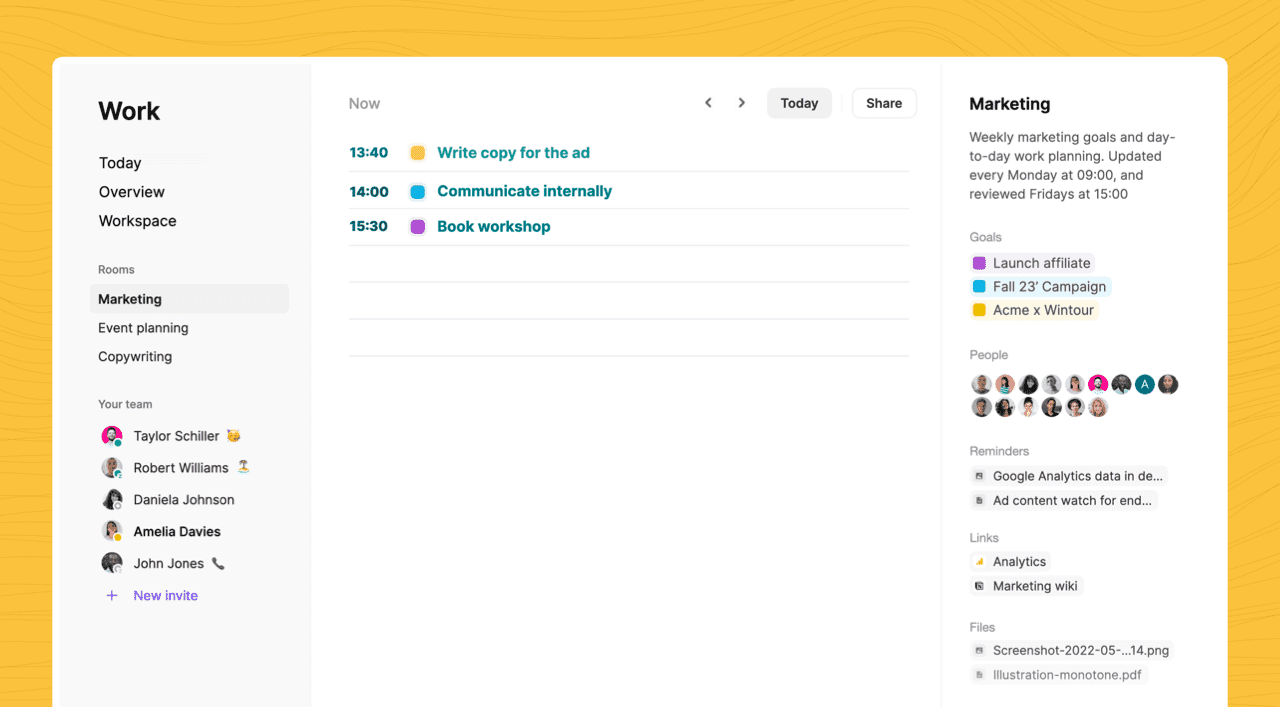Pembio
A curated collection of resources, worksheets and templates within the productivity space.
Get the app ✌️Impact of goal setting on a worker's performance
It is commonly considered that employees who are driven to do their best work are the most desirable to employers. But how do we motivate people to perform at their highest level, consistently? Is the use of monetary incentives the only method for boosting the motivation of workers, or are there other methods as well? Bet you know the answer already…
Setting objectives for oneself or having goals handed down from management is one method that has been shown to boost employee performance. The achievement of goals is an excellent incentive for employees and can increase overall productivity in a business.
However, objectives may have unintended and potentially harmful effects if they are not selected with care or if they are used inappropriately. Setting goals is an effective method that, when used, requires care and thoughtfulness.

How does goal setting improve worker performance?
Here we will talk about the impact of goal setting on worker performance. These are the following:
Involve employees from start-to-finish
Since the purpose of goals is to guide employees’ efforts, and to enable them to grow as professionals, it stands to reason that employees should be involved in the goal-setting process itself. Securing employees' buy-in allows you to assist them in developing both short-term and long-term objectives, and it also raises the likelihood of the goals actually being achieved.
It is recommended that managers work together to set SMART objectives. Inspiring dedication and giving folks a feeling of ownership in reaching the goals is a direct result of doing so. In addition to helping push performance to new heights, encouraging workers to establish ambitious objectives acts as an incentive for continued professional growth.
Motivation
There are goals to be found in every aspect of human existence and every organization. In our personal lives, for instance, many of us want to reduce our spending and live more healthily, for example.
Similarly, politicians work for a wide variety of issues, including the economy, reducing carbon dioxide emissions, creating more jobs and increasing wages, to name a few. And in our professional lives, a lot of people strive for tenure or to advance to higher positions. We therefore work hard to meet specific sales quotas, revenue targets, project milestones, production targets, etc..
Some of these objectives are pretty explicit, while others are more general; some are legally enforceable, and financial rewards support others. And although the individual consciously selects some goals, others result from pressure from the outside world.
Link individual goals to business objectives
Companies with excellent performance management systems report that the objectives of their workers are related to the firm's priorities 91% of the time.
The rationale for this is straightforward: if workers are made aware of how their objectives relate to the organization’s bigger goals, they will be more aligned with the mission and therefore more motivated and productive. In current years, businesses have been connecting organizational business goals to functional business objectives and turning them into team performance goals.
This trend has primarily been driven by the need to improve organizational efficiency. Individuals can better understand the direct consequence of their performance, which drives responsibility and leads to improved performance.
Adapt goals in real-time
Never consider your goals to be set in stone; instead, see them as fluid and ever-evolving targets. Setting objectives at the beginning of the year and then failing to revisit them until the time comes for annual reviews is often a mistake.
The failure to reassess objectives regularly may be demotivating because of the many changes in circumstances that occur during the year. That does not mean, however, that objectives should be treated as moving targets; instead, they should be modified in response to the shifting conditions in the environment.
For instance, objectives may need revision if the circumstances on which they were based change. By adding a level of flexibility in goal-setting, you can ensure that people remain motivated because the objectives of their efforts are truly relevant for their team and the organization.
Create responsibility for your actions
Setting goals is a powerful tool to hold oneself responsible for the outcomes you have set out to achieve. When you document your objectives, you place yourself in a standing where you are directly accountable for whether or not you reach them.
If you can realize all of your objectives, you will be satisfied knowing that your work contributes to accomplishing bigger organizational goals. At the same time, if you don’t achieve what you set out to do, you have gained valuable experience as to why you didn’t reach the goal in question, and can adjust your efforts (or goal) accordingly next time.
Failure is not always a negative result, and it is essential to keep this in mind since very few of us accomplish what we set out to do without running into obstacles along the road.

Achieving one's objectives might lead to a more contented work life.
It is difficult to beat the pleasure you get when you fulfill objectives, no matter how small they may be. This feeling of accomplishment is equally true for achievements large and small.
Monitoring goal success can also boost your overall employee satisfaction and retention rate, because it helps people understand how their efforts influence the bigger picture, and the company’s mission. Recognising employee’s efforts to reach goals also helps establish a culture where everyone has a sense of being appreciated. Clearly, this is a significant benefit to any and all businesses.
Conclusion
People are motivated to develop themselves when they have goals to work towards. When considering how to evaluate the performance of a business, it is essential to be aware that creating attainable objectives assists you and your team define where you want to go and to monitor your progress toward that destination.
By: Johan Flodgren

The goal planning app that will skyrocket your productivity
A brand new productivity app - empowering you, or your entire team, to get the most important work done with stunningly simple goal planning.
Get started for free